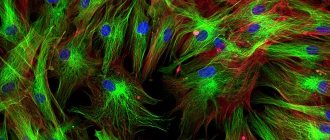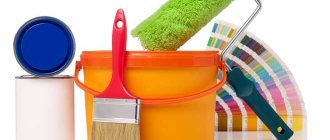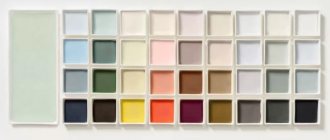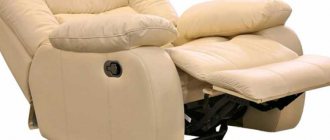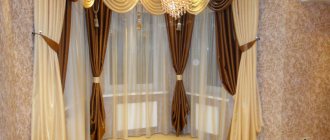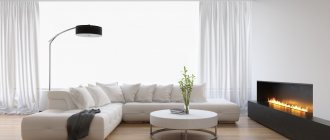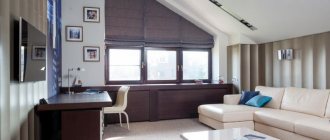Textured paint for interior decoration: features of use
To decorate the interior of living rooms, you can use any textured paint intended for interior decoration.
Most often, preference is given to acrylic and silicone compounds. However, it is also possible to use mineral compositions. When decorating the interior, not only the entire walls or ceiling, but also individual zones can be decorated. Using these compositions, columns, pilasters or beams are formed. We offer you to look at interesting solutions that were used in the design of various rooms:
Textured paint for exterior use
Manufacturers offer a wide range of products for facade finishing. When choosing a suitable option for outdoor work, you should pay attention to compositions based on:
- vinyl. The binder is plastic or vinyl filler. This material is only relevant for outdoor work. The formed coating exhibits low permeability, but at the same time has high adhesion. Can be applied to any substrate, protecting them from negative external influences. The composition is difficult to work with;
- acrylic. Large range of colors. Easy to apply. Possibility of forming intricate reliefs. The coating is exposed to ultraviolet radiation;
- silicone Modern textured paint is used to form a durable, vapor-permeable coating that protects the base from moisture and other negative factors. Helps disguise defects;
- polymers or silicates. Liquid glass is the main component used in the formation of paint and varnish coating on the facade. With high vapor permeability, it demonstrates good adhesion to the base. Repels pollution, protects against external factors;
- mineral components. The basis is cement. Due to low resistance to temperature fluctuations, cracks may appear on the surface after winter, which limits its use in façade design.
Preparing walls for painting
The walls must first be cleaned of dirt. This can be done with water, detergent and a cloth. Use a spatula or scraper to remove any remaining old coating. If there are cracks or gouges on the surface, fill them with acrylic putty. Once completely dry, coat the entire wall with primer. Leave to dry for approximately 12 hours.
Preparation before painting is required. Texture material can hide only minor wall imperfections. And the primer will help the paint adhere more firmly to the surface.
Paint is usually sold in powder or liquid form. First, read the instructions, dilute the powder with water using a construction mixer, and mix the finished paint thoroughly. Now you can add color pigment or mix several paints to achieve the desired shade. The pigment should be added while mixing, so the consistency of the paint will be as uniform as possible.
Do a test job before starting painting. Make a few test strokes with a roller on a small piece of cardboard.
Adding fillers yourself
The specificity of the mixtures not only allows, but also implies experiments with the composition. By adding certain ingredients, you can adjust the structure of the relief and its thickness, change the tactile sensations of the finished surface, or functionally adapt it for a specific room.
Do-it-yourself textured paint provides complete scope for creativity. Possible additives:
- sand;
- stone chips;
- fabric fibers;
- reflective elements, broken glass;
- seashells;
- sawdust and much more.
With the help of special additives it is possible to achieve effects in which the coating will look like fabric, cork, silk or metal. And from the photo the textured paint will be completely unrecognizable.
However, you need to understand that if you overdo it with additives, this will give the desired appearance, but will not have a positive effect on the quality and durability of the result.
Advantages and disadvantages
Advantages:
- Resistance to high and low temperatures.
- Moisture resistance.
- Plasticity and elasticity, which makes it easy to apply paint and avoid cracks.
- Many texture paints contain antiseptic additives, which prevents mold from forming.
- Repels dust and dirt.
- Harmless to humans, as there are no harmful chemical impurities.
- Wide range of uses. There are structural paints for plastic, wood, stone, ceramics, concrete, metal and more.
- The ability to create any design and pattern.
- You can add coloring pigments to give the base the desired shade.
- Unusual appearance.
- Durability of operation – at least 10 years.
- High degree of strength - withstands any mechanical impact.
- Does not fade in the sun.
- Easy to care for.
- Unlike wallpaper, textured paints for ceilings and walls do not get dirty in places where they are frequently touched (switches, etc.).
- Surfaces coated with them “breathe”.
The disadvantages include significant consumption: per 1 sq. m. 1 kg of coloring agent is required.
Methods for manually giving relief
In obtaining a unique pattern, an alternative or addition is the method of applying textured paint to the surface. Using ordinary tools and improvised means, without special artistic abilities, you can obtain results that can be called works of art with a clear conscience.
A simple spatula allows you to imitate a rocky surface; all you need to do is cover the wall with cross layers with clear, quick movements. For most people who know the basics of repair, this effect occurs spontaneously, without intent.
But sponges and rollers are designed to obtain a more conscious and solid, but uncomplicated “torn” coating, which can often be seen on the facades of old Soviet buildings of the Stalin era.
And don’t let the peeling appearance of such buildings bother you, they have already outlived their usefulness, and besides, the use of modern silicate solutions will allow you to avoid such a fate.
A simple coarse fabric will provide an original texture, although in this case you will need to choose the right color scheme, otherwise the idea will be noticeable only upon closer inspection.
Brushes with stiff bristles, crumpled paper, as well as ropes that can be wound around a roller and see a semblance of bamboo thickets on the wall will be useful for those who love a creative approach.
The use of stencils and household items stands out. Or even your own hands and feet. For example, textured paint on the ceiling, decorated in this way, is unlikely to leave anyone indifferent.
Types of texture paint
By backing up your ideas with consultation from an experienced specialist or armed with your own knowledge, it is possible to achieve the desired imitation so that the ceilings and walls in the house appear visually made of wood, textiles, or natural stone.
By adding sawdust or quartz sand, you can create, as desired, a surface with a rough relief or provide its original appearance by adding sharp edges.
For a decorative effect, the following are also used: granite and marble crumbs, metal particles, modified starch, various fibers of natural and silicone origin, modified gas silicate additives, silk and mother-of-pearl pigments.
The described paint and varnish materials, depending on the initial composition and the fillers used, are divided into the following varieties. For interior work, options can be used to obtain original surfaces.
- Mizuri with the addition of acrylic starch to the initial mixture. The dye can be applied to smooth surfaces, but is especially effective for creating relief protrusions.
- Marseille wax has a special uniqueness and style. To imitate bark or old stone, glaze paint is additionally applied to the wall. Wax treatment forms a film that is resistant to moisture.
- Atacama creates a reflective effect on the surface. To do this, metal shavings and quartz sand are added to the general composition of the dye.
- Mother of pearl can change the overall shade under the influence of the reflection of sunlight, imitating silk fabric. At the same time, the space visually expands.
- Velvet or velor also create the effect of the mentioned fabrics. To obtain the desired result, multi-colored solid particles are added to the dye.
- Granite imitates the surface of this stone. A similar illusion is created by acrylic bubbles. When the material is applied to a surface, the result is a granite texture.
The relief is created using quartz chips and sawdust, and is lightweight and easy to apply. Natural components are also used to create certain decorative qualities.
It is advisable to order the selected shade from the manufacturer to obtain the quality that is so important in repairs. The products of Amourcolor, a company specializing in the production of coatings for textured decor, are famous for their impressive range of options, and the materials are highly wear-resistant. Among them:
- environmentally friendly Perlata dye, which contains pigments similar in appearance to pearls, which adds a touch of luxury to the interior;
- Escenta will decorate the room with eye-catching, rich tones;
- Tactite imitates the original marble mosaic.
The Paritet-Decor company can also boast of the quality of its products. The company also offers a wide range of samples. Among the options:
- Matiere - the material gives the treated surface a resemblance to expensive fabric or natural wood, with which the paint can emphasize the luxury of the environment;
- Marrakech is suitable for rooms decorated in Moroccan style, combining modern achievements and wood technology, bringing peace and harmony to the home;
- Les Perles contains pearlescent pigment, gives the surface a visual feeling of elegance and purity due to successful color transitions that create an association of clouds and waves;
- Craquelee creates a surface similar to antique canvas, suitable for antique-style spaces.
For facade work, textured paints are very often used today by owners of private houses, since the use of such material does not require special experience or special skills. The most popular are the varieties of facade texture paint .
- Granular silicone paint. It has the property of imparting a matte tint to the treated surfaces. The material is perfect for lime and concrete walls, being endowed with not only decorative, but also thermal insulation abilities. The dye fits perfectly on walls, dries quickly, absorbs oxygen and is odorless.
- Texture acrylic paint . This material has all the advantages of the previous type, but is created on a different structural basis. Before applying the dye to the surface, it is cleaned of dirt and dust. Since the work is carried out outdoors, it is important to take into account the vicissitudes of the weather. During painting, there must be no precipitation and the temperature must be above 0°C. If these standards are observed, the paint material dries within 24 hours.
There are types of dyes suitable for exterior and interior decorative work at the same time. These include “ Universal texture paint .
This material forms a weather-resistant, vapor-permeable coating, hides unevenness, and is intended for finishing the surface of buildings with a brick, concrete and cement base, as well as for interior spaces: corridors, baths, kitchens.
Texture dyes may contain mineral (made from cement and lime) binders. This material is considered the most inexpensive. Silicate-based paints are much more expensive, but they are of the best quality.
Textured paint is divided into the following types according to grain type:
- fine-grained with a filler diameter of less than half a millimeter;
- medium textured sizes are considered to be from 0.5 to 1 mm;
- coarse-grained ones contain filler over 1 mm in diameter.
The created relief depends on the listed indicators. What it will be like depends on the tastes, fantasies and preferences of the owner. But the final choice is not at all simple, because you should take into account the purpose of the facade being repaired or the internal structure of the building, the type of surface being treated, and the combination of the created image with other design elements. Therefore, in order not to make a mistake, sometimes a preliminary consultation with an experienced, knowledgeable specialist is simply necessary.
Review of manufacturers
The manufacturer Amourcolor produces high quality textured paints that are resistant to wear. Buyers are provided with 3 product options: Tactite with a suede surface or mosaic, Perlata with a pearl sheen and Escenta with a variety of undertones. All paints are water-based and environmentally friendly.
Domestic offers paints with various textures: embossed, “Mizuri”, “wet silk” and others. All products of high quality can be purchased at a competitive price.
The Russian company VGT has been producing paint and varnish products since 1992. It is possible to purchase various types of textured paints: facade and interior, water-based, crack-resistant.
The product is ideal for our climate. There are a lot of positive reviews about it. In the video below you can watch a master class on applying textured paint with the “Travertine” effect.
Manufacturer from France Blancolor supplies many types of durable materials for decorative wall decoration. Among them are translucent paint Essuyables, silk based on cellulose fibers Tradimurs, waxed plaster effect Effets Platre Cires and many other types.
Textured paints from the manufacturer Clavel have a variety of colors and perfectly imitate silk, brocade, and velvet on walls. There are different types of designs ranging from antique to modern. The composition uses environmentally friendly components.
Useful tips
Before you take up the tool, it makes sense to study additional useful recommendations from specialists and simply those who have worked with this type of material for wall decoration:
- Before starting work, the entire paint mixture should be placed in a clean container and warmed to room temperature, then mixed thoroughly. It is best to use a construction mixer for this, which should also be clean. A special nuance that facilitates mixing lies in the ability to add water to the initial composition, the total volume of which will not exceed 7% of the volume of the entire material;
- You should first coat the surface with a primer, preferably acrylic. This will increase the degree of adhesion of the paint to the surface, regardless of the composition of the materials;
- When choosing a primer for a wall, you should pay attention to its color - ideally it should match the color of the selected texture material. Also, the primer must be applied in an even layer.
To paint chaotic patterns on the walls, use a soft brush. With its help, the desired pattern is applied to the surface that has not yet hardened. If you wrap a thick rope, intertwined in different directions, around a roller and walk it several times over the painted surface, you can create an imitation of bamboo stems on the wall.
What to consider when choosing?
For a bedroom, living room or hall, it would be good to choose textured paint like velvet or silk; the choice depends on other interior details and the preferences of the owners. For the ceiling of a living room in an apartment, you should use types that are not too prominent, preferably light colors.
In rooms with high humidity, it is worth choosing waterproof or water-dispersible paint for the bathroom. In the kitchen, where there is a high probability of contamination, a washable type of such coatings will be relevant.
For facade work, you need to buy appropriate brands that are resistant to adverse weather conditions. Acrylic that fades in the sun should not be used, but it is better to choose vinyl varieties.
Options for obtaining the required invoice
To obtain an unusual relief, there are various methods that use a variety of tools and devices.
- Brushes and brushes. This is the simplest option, allowing you to draw stripes that form patterns. Vertical, horizontal, diagonal and wavy directions are considered traditional, but you can show your imagination.
- Comb. Gives a similar result, but differs in more pronounced stripes. However, to obtain complex patterns you need to practice.
- Putty knife. This tool is used to create a rock relief that replicates natural rock. First you should choose the width of the blade: the smaller it is, the more complex the terrain. To apply the pattern, chaotic strokes are made with a spatula, after which the surface is slightly smoothed with a clean tool. A layer of tinting is placed on top.
For textured finishing, a special versatile tool is used - Simple roller. A foam coat leaves behind a fine-grained texture, while a fleece coat leaves behind stripes, the size and depth of which depends on the size of the hairs.
- Curly roller. The pattern is obtained from the drawing on the roller.
- Foam sponge. The walls are literally stamped with this device. The main thing is to avoid clear boundaries.
In general, any suitable materials and tools can be used for the job. Even with your hands you can create an interesting relief.
If desired, with simple tools you can create genuine masterpieces on the walls
Advice! It is recommended to test all created effects on a small area of plywood or cardboard, this will give you an idea of the final result.
Textured wall paints with unusual effects
In addition to the standard coating, textured wall paints allow you to create a layer with various effects. Compositions with the effect of mother-of-pearl or silk look impressive. This type is relevant for small rooms that you want to fill with light. Silk plaster comes in predominantly light colors. The direction of the light flux changes the shade of these coatings, which is why they are sometimes called “chameleons”.
Attention! Externally, the coating looks like stretched silk fabric with a characteristic pearl sheen created by pigment additives.
“Wet silk” looks no less impressive, including cotton or cellulose fibers with polymer pigments of various colors. This decor will help create a special atmosphere in the room. In the rays of light, the pattern shimmers, changing shade.
Granite dye also looks impressive, getting its name for its realistic imitation of texture, and not for its presence in granite chips. For formation, paint of various shades is used, applied to the surface using a spray gun.
Types of created coatings
To create a unique decor, you need to wisely choose the paint itself and its combination with all kinds of additives. This plays a determining role in how organically the materials used will fit into the overall stylistic concept of the room. The coatings created can be divided into the following main types :
- "Relief". As the name implies, it gives surfaces a relief effect. This is achieved by applying a textured material to which a combination of sawdust and quartz chips is added. The desired degree of relief is achieved quite simply: you just need to adjust the size of the particles that are used as additives;
- "Mizuri." The glossy shine characteristic of this coating makes it no less popular than the relief type. To obtain such a shine, after the material has dried, it must first be diluted with the required amount of water and modified starch;
- "Atacama". The reflective effect of this coating creates an extraordinary optical effect of a surface with a velvety structure. To achieve this, an acrylic base, quartz sand and metal filings are combined in certain proportions;
- "Marseille wax". With this type of coating, both professional and novice designers will be able to unleash their creative abilities. It can imitate tree bark, all kinds of natural stone, climbing vines and much more. After the paint has dried, decorative wax is applied to the surface, designed to give the overall picture the effect of depth and luxury.
Also, sometimes random stains are created on the wall, imitating wet silk. This is done by applying shiny paint with a roller or wide brush, but not with a sprayer.
